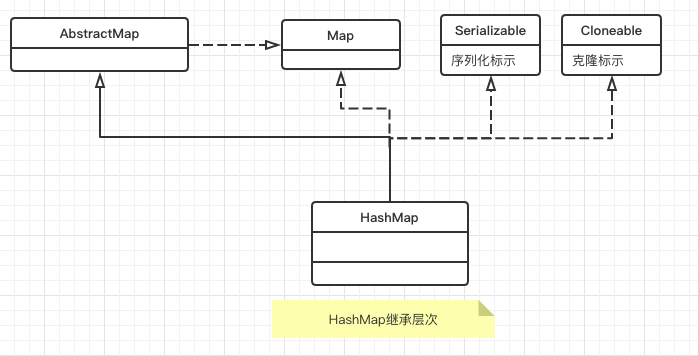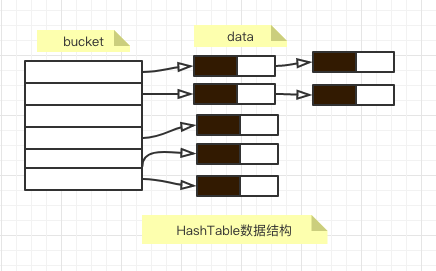首先看看HashMap在JDK中的继承层次:

在HashSet中,我们说过元素使用hashcode保存的存储结构:

保存的键值对根据键得到hashcode,然后和bucket总数取余得到位置索引,然后将数据保存到后面的链表中。
在HashMap中定义了一系列的属性,看看都有什么,先不管什么意思,使用到的时候再说:
// 默认的容量初始化大小
static final int DEFAULT_INITIAL_CAPACITY = 1 << 4;
// 最大的容量
static final int MAXIMUM_CAPACITY = 1 << 30;
// 默认的加载因子
static final float DEFAULT_LOAD_FACTOR = 0.75f;
// 限定值,如果超过这个值,将链表转为红黑树
static final int TREEIFY_THRESHOLD = 8;
// 少于这个值,红黑树转为链表
static final int UNTREEIFY_THRESHOLD = 6;
// 避免扩容和树形化的冲突,元素必须大于这个值,才扩容。这个值大于 4 * TREEIFY_THRESHOLD
static final int MIN_TREEIFY_CAPACITY = 64;
构造器有三个:
public HashMap() {
this.loadFactor = DEFAULT_LOAD_FACTOR; // all other fields defaulted
}
public HashMap(int initialCapacity) {
this(initialCapacity, DEFAULT_LOAD_FACTOR);
}
public HashMap(int initialCapacity, float loadFactor) {
if (initialCapacity < 0)
throw new IllegalArgumentException("Illegal initial capacity: " +
initialCapacity);
if (initialCapacity > MAXIMUM_CAPACITY)
initialCapacity = MAXIMUM_CAPACITY;
if (loadFactor <= 0 || Float.isNaN(loadFactor))
throw new IllegalArgumentException("Illegal load factor: " +
loadFactor);
this.loadFactor = loadFactor;
this.threshold = tableSizeFor(initialCapacity);
}
- 在三个构造器中可以看出,HashMap的构造只是设置了记载因子和初始化容量的大小,其余属性都是属性的默认值。而且也么有创建任何对象,或者数组。
那么看看往HashMap放入数据的时候呢:put方法如下:
public V put(K key, V value) {
return putVal(hash(key), key, value, false, true);
}
- 传入一个key/value参数,在put方法中调用了别的方法,putVal和hash方法,前面我们知道hash表中是根据hashcode确定元素位置的,那么这个hash方法应该就是计算hashcode的:
static final int hash(Object key) {
int h;
return (key == null) ? 0 : (h = key.hashCode()) ^ (h >>> 16);
}
- hash方法接收一个Object类型的参数,返回int,也就是hashcode,这门我们可以知道,HashMap中的hashcode是根据键计算的,与值无关。
- 再看计算的方法,首先判断key是否为null,是的话返回0,负责使用key的hashCode 与自身右移16位得到。
得到的hashcode,再看看putVal方法:
/**
*
* @param hash hash for key 键的hashcode,hash方法计算得到
* @param key the key。放入的key
* @param value the value to put。放入的value
* @param onlyIfAbsent if true, don't change existing value 是否修改已经存在的值,默认为false
* @param evict if false, the table is in creation mode.
* @return previous value, or null if none 返回原来的值,如果没有返回null
*/
final V putVal(int hash, K key, V value, boolean onlyIfAbsent, boolean evict) {
// tab 存储数据的bucket,p存储key/value的Node, n 表示bucket的长度
Node<K,V>[] tab; Node<K,V> p; int n, i;
//判断bucket是否为null或者长度为0
if ((tab = table) == null || (n = tab.length) == 0)
n = (tab = resize()).length; // 为null就初始化bucket,也就是tab
// bucket长度和key的hashcode逻辑与运算,也就是相当于求余操作得到数据再kucket中的位置
if ((p = tab[i = (n - 1) & hash]) == null)// 如果这个位置位置为 null
tab[i] = newNode(hash, key, value, null); // 那么直接创建Node将k/v插入
// 如果得到的位置不为null,已经有元素存在了
else {
Node<K,V> e; K k;
// k 重复, e 直接等于存在的Node p
if (p.hash == hash &&
((k = p.key) == key || (key != null && key.equals(k))))
e = p;
// 不是k重复的情况,那么就需要插入这个元素,如果p是TreeNode,
// 说明现在不是链表,而是红黑树,执行将值插入红黑树的操作
else if (p instanceof TreeNode)
e = ((TreeNode<K,V>)p).putTreeVal(this, tab, hash, key, value);
// 不是k重复的情况,那么就需要插入这个元素,而且现在也不是红黑树
// 那么执行链表的插入值方法
else {
// 开始循环这个位置的链表
for (int binCount = 0; ; ++binCount) {
// 下一个为null,直接插入
if ((e = p.next) == null) {
p.next = newNode(hash, key, value, null);
// 插入之后判断元素个数超过 TREEIFY_THRESHOLD没有,超过就转链表为红黑树,并停止循环
if (binCount >= TREEIFY_THRESHOLD - 1) // -1 for 1st
treeifyBin(tab, hash);
break;
}
// 下一个不为null,那么再次只用k的hashcode判断是否重复,重复直接停止循环
if (e.hash == hash &&
((k = e.key) == key || (key != null && key.equals(k))))
break;
p = e;
}
}
// 找到了k相同的Node,判断是否使用新值替换旧值
if (e != null) { // existing mapping for key
V oldValue = e.value;
if (!onlyIfAbsent || oldValue == null)
e.value = value;
afterNodeAccess(e);
return oldValue; // 返回旧值
}
}
++modCount;
if (++size > threshold)。// 判断是否需要扩容
resize();
afterNodeInsertion(evict);
return null;
}
- 插入的方法就是上述的三个主要方法,具体的都写在注释了。
- 在插入的过程中,有几个重要的方法和参数。比如添加完成后判断是否需要扩容时的threshold,它的大小是 (capacity * load factor).
- 还有就是resize方法:
/**
* Initializes or doubles table size. If null, allocates in
* accord with initial capacity target held in field threshold.
* Otherwise, because we are using power-of-two expansion, the
* elements from each bin must either stay at same index, or move
* with a power of two offset in the new table.
*
* @return the table
*/
final Node<K,V>[] resize() {
Node<K,V>[] oldTab = table;
int oldCap = (oldTab == null) ? 0 : oldTab.length;
int oldThr = threshold;
int newCap, newThr = 0;
if (oldCap > 0) {
if (oldCap >= MAXIMUM_CAPACITY) {
threshold = Integer.MAX_VALUE;
return oldTab;
}
else if ((newCap = oldCap << 1) < MAXIMUM_CAPACITY &&
oldCap >= DEFAULT_INITIAL_CAPACITY)
newThr = oldThr << 1; // double threshold
}
else if (oldThr > 0) // initial capacity was placed in threshold
newCap = oldThr;
else { // zero initial threshold signifies using defaults
newCap = DEFAULT_INITIAL_CAPACITY;
newThr = (int)(DEFAULT_LOAD_FACTOR * DEFAULT_INITIAL_CAPACITY);
}
if (newThr == 0) {
float ft = (float)newCap * loadFactor;
newThr = (newCap < MAXIMUM_CAPACITY && ft < (float)MAXIMUM_CAPACITY ?
(int)ft : Integer.MAX_VALUE);
}
threshold = newThr;
@SuppressWarnings({"rawtypes","unchecked"})
Node<K,V>[] newTab = (Node<K,V>[])new Node[newCap];
table = newTab;
if (oldTab != null) {
for (int j = 0; j < oldCap; ++j) {
Node<K,V> e;
if ((e = oldTab[j]) != null) {
oldTab[j] = null;
if (e.next == null)
newTab[e.hash & (newCap - 1)] = e;
else if (e instanceof TreeNode)
((TreeNode<K,V>)e).split(this, newTab, j, oldCap);
else { // preserve order
Node<K,V> loHead = null, loTail = null;
Node<K,V> hiHead = null, hiTail = null;
Node<K,V> next;
do {
next = e.next;
if ((e.hash & oldCap) == 0) {
if (loTail == null)
loHead = e;
else
loTail.next = e;
loTail = e;
}
else {
if (hiTail == null)
hiHead = e;
else
hiTail.next = e;
hiTail = e;
}
} while ((e = next) != null);
if (loTail != null) {
loTail.next = null;
newTab[j] = loHead;
}
if (hiTail != null) {
hiTail.next = null;
newTab[j + oldCap] = hiHead;
}
}
}
}
}
return newTab;
}